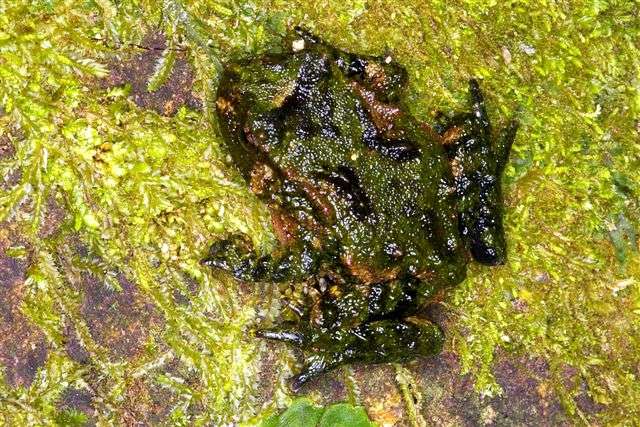Hochstetter's frog
| Hochstetter's frog | |
|---|---|
 | |
| Scientific classification | |
| Kingdom: | Animalia |
| Phylum: | Chordata |
| Class: | Amphibia |
| Order: | Anura |
| Family: | Leiopelmatidae |
| Genus: | Leiopelma |
| Species: | L. hochstetteri |
| Binomial name | |
| Leiopelma hochstetteri Fitzinger, 1861 | |
| | |
| Range (does not show Maungatautari) | |
Hochstetter's frog (Leiopelma hochstetteri) is a primitive frog native to New Zealand, one of only four extant species belonging to the taxonomic family Leiopelmatidae. They possess some of the most ancient features of any extant frogs in the world.[1]
Taxonomy
Hochstetter's frog is named after the German geologist Ferdinand von Hochstetter. This species is endemic to New Zealand and belongs to the most primitive anuran order Archaeobatrachia, along with Archey's frog (L. archeyi), Hamilton's frog (L. hamiltoni), and the Maud Island frog (L. pakeka). Three species within the genus, L. auroraensis, L. markhami, and L. waitomoensis, are extinct.
Description
Hochstetter's frog has a brown-green to brown-red top with dark bands and warts, yellow-brown bellies, and can range from 24 to 48 mm snout-vent length as adults. They are nocturnal, staying under refugia during the day. Hochstetter’s frog prefers moist gaps under shaded debris, like rocks and logs and along streams and seepages in native temperate rainforest. They are carnivorous, preying on invertebrates such as spiders, beetles, and mites.[2] All native New Zealand frogs (pepeketua in Maori) all share tail-wagging muscles, inscriptional ribs, round pupils, and a lack of eardrums, eustachian tubes, and vocal sacs. These frogs, more similar to salamanders than modern frogs, use chemical signals over acoustic signals to mark habitat and recognize competitors.[3] Hochstetter’s frogs poor hearing is complemented by their lack of vocalization, except for when mating or disturbed.
Lifecycle
Hochstetter's frogs can live to 30 years old. Adults do not breed until they are three years old, laying up to 20 eggs each season.[4] While all four species develop as tadpoles inside the egg, hatching as froglets with developed back legs, Hochstetter’s frogs, as the only semiaquatic species, continue to develop in water while the three other species are cared for by their parents.[5]
Distribution
Subfossil remains indicate all native species were once widespread across New Zealand until roughly 200 years ago.[6] Hochstetter's frogs have the most extensive distribution of the native frogs, spanning the upper North Island, including the Waitakere and [Hunua Ranges], the Coromandel Peninsula, Great Barrier Island, [Maungatautari Ecological Island], and the East Coast.[7] Ten populations of this species have been found to be genetically distinct, owing to the history of glacial isolation.[8]
Threats
Invasive pests like the kiore, frogs, goats, and pigs have caused declines in the species' population. The kiore, or Polynesian rat, was brought to New Zealand by the Maori, causing extinction on the South Island and large-scale destruction of populations on the North Island before 1700 AD. When threatened, native frogs attempt to elude capture by staying camouflaged, secreting an unpalatable chemical, and occasionally jumping into a nearby water body. Introduced browsers, such as goats and pigs, have been thought erode habitat along streams and reduce the amount of vegetation providing shade. Habitat modification and destruction has been paramount in reducing populations. Local mining can cause sediment runoff that reduces stream quality and can even poison frogs. Logging and the resulting forest clearing can pose similar issues to stream quality. The global chytrid fungus epidemic, transmitted through soil, has caused steep declines in Archey’s frog populations and is thought to pose a threat to Hochstetter’s frogs, as well.
Conservation
Under the New Zealand Threat Classification scheme, Hochsetter’s frog is listed as “At risk-declining” while the IUCN has classified the species as “Vulnerable”. All native frogs are protected under the New Zealand Wildlife Management Act of 1953. The Kokako Management Area in the northern Hunua Ranges has been undergoing pest control since 1994 to provide suitable habitat for the conservation of kokako, an endangered forest bird. Surveys of Hochstetter’s frogs in the area have shown numbers of young frogs have jumped from 10% to 30% in 2005.[9]
References
- ↑ Bell; et al. (2004). "Leiopelma hochstetteri". IUCN Red List of Threatened Species. Version 2006. International Union for Conservation of Nature. Retrieved 11 May 2006.
- ↑ Shaw, S.D.; L.F. Skerratt; R Kleinpaste; L Daglish; P.J Bishop. "Designing a diet for captive native frogs from the analysis of stomach contents from free-ranging Leiopelma". New Zealand Journal of Zoology. 39 (1): 47–56. doi:10.1080/03014223.2011.619989.
- ↑ Waldman, B; P.J. Bishop (2003). "Chemical communication in an archaic anuran amphibian.". Behavioural Ecology. 15 (1): 88–93. doi:10.1093/beheco/arg071.
- ↑ Wilson, K-J (2004). Flight of the Huia. Christchurch: Canterbury University Press.
- ↑ Wilson, K-J (2004). Flight of the Huia. Christchurch: Canterbury University Press.
- ↑ Worthy, T.H. (1987). "Osteology of Leiopelma (Amphibia: Leiopelmatidae) and descriptions of three new subfossil Leiopelma species". Journal of the Royal Society of New Zealand. 17: 201–251. doi:10.1080/03036758.1987.10418160.
- ↑ Bishop, P.J. (2013). "Native frog (Leiopelma spp.) recovery plan, 2013—2018". Threatened Species Recovery PlanDepartment of Conservation, Wellington. Threatened Species Recovery Plan: 39 pages.
- ↑ Gleeson, D; C Clay; N Gemmell; R Howitt; A Haigh (2010). "Summary report: Leiopelma hochstetteri population genetic structure". Landcare Research contract report LC 077 for the Department of Conservation (unpublished): 18 p.
- ↑ Knill, K. "Native frogs in the Hunua on the increase". Retrieved 2005. Check date values in:
|access-date=(help)
